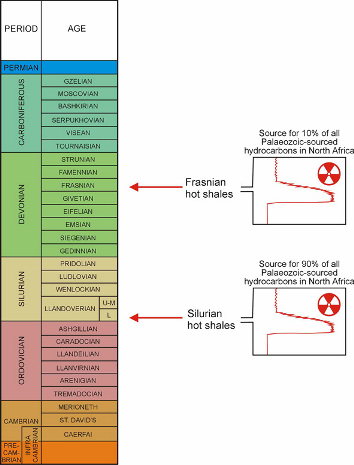Silurian and Devonian black shales in North Africa and the Western Interior Basin
Sebastian Lüning
Lower Silurian and Upper Devonian (Frasnian-Famennian) organic-rich
(‘hot’) shales are the origin of almost all Palaeozoic-sourced
hydrocarbons in North Africa. They contain up to 17% TOC and in well logs
are characterised by high gamma radiation associated with high uranium
contents at or near the base of the shale succession. The two hot shale
units have been studied in detail across North Africa by means of well
logs, biostratigraphy and geochemistry and the results have been summarised
in Lüning et al. (1999; 2000a, b; submitted; see references list).
The results of this study clearly suggest that more detailed, focused,
biostratigraphic and palaeoecological data is crucial for refined depositional
models and more sophisticated evaluations of the regional source rock
potential.

Despite the obvious similarities in organic richness and log response, the lower Silurian and Frasnian hot shales differ from one another in a number of important aspects:
Importance of source rock: It has been estimated that the lower Silurian hot shales are the origin of 90% of all Palaeozoic-sourced hydrocarbons in North Africa, whereas the Frasnian black shales have sourced the remaining 10%. The comparatively lower contribution of the Frasnian source rocks to hydrocarbon generation may be explained by their less widespread regional distribution and their lower thermal maturity due to their higher stratigraphic position.
Correlation of organic content with gamma ray values: A TOC value of 3% correlates in the lower Silurian hot shales with a gamma ray value of approximately 200 API, while in the Frasnian it corresponds to only ca. 150 API.
Maximum thickness of shales >3% TOC: The lower Silurian hot shales in the Ghadames and Murzuq basins rarely exceed 25 m in thickness. In contrast, Frasnian organic-rich strata with TOCs >3% have thicknesses of locally more than 200 m (in the Algerian part of the Ghadames/Berkine Basin).
Depositional model: We interpret the lowermost Silurian hot shales to
have been deposited during the initial transgression, after melting of
the late Ordovician glaciers. Their origin is assumed to be associated
with restricted circulation with flow barriers formed by emergent or shallow
highs associated with the late Ordovician palaeorelief. In addition, high
primary productivity conditions may have prevailed along the shelf edge
at this time.
In contrast, the Frasnian hot shales are interpreted to have been deposited
during peak sea-level in association with a rise of the oxygen minimum
zone.
More work has to be carried out on the two hot shale units in Libya. Of high importance are, for example, detailed biostratigraphic studies based on graptolites (Silurian) and conodonts (Frasnian) using core material. Palynomorphs provide important age data but do not have the required level of biostratigraphic resolutions for detailed intra- and inter-basin correlations. In some areas of the Ghadames Basin the usual Early Llandoverian, basal Silurian hot shale horizon is complemented by an additional organic-rich unit of Late Llandovery-Wenlock age. The exact distribution and depositional mechanisms of this latter hot shale event are largely unknown and need to be investigated in more detail.
More information on field-based gamma-ray spectroscopy in sedimentology
Gamma-ray logs are a standard tool in hydrocarbon and minerals exploration. Few people know that there are also portable gamma-ray spectrometers available which allow field-based gamma measurements. Main fields of application in sedimentology are (1) approximation of organic content of marine black shales based on the uranium content, (2) apatite concentration of phosphorites based on the uranium content, and (3) approximation of the general shale mineralogy based on Th/K crossplots.
The field-based gamma-ray spectroscopy technique has the following advantages over lab-based analyses:
- Continuous sampling
- Ready availability of data
- Cost-effective
- Non-destructive
- Relict uranium in weathered strata
Currently, we test the applicability of spectrogamma data as a proxy for the organic richness in black shales in a comparative study involving the lower Silurian, upper Devonian and mid Cretaceous (Cenomanian-Turonian boundary) black shales of North Africa. First results indicate that for a given TOC value, the uranium content has gradually decreased from the Silurian to the Cretaceous, with intermediate values found in the Devonian. While in the Upper Devonian and Lower Silurian the gamma-ray curves may be used as proxies for the organic richness in black shales, this is more complicated and partly impossible in Cretaceous strata, especially in carbonates. In the Cretaceous, other log-based techniques using sonic and resistivity values are more promising tools to predict TOC values.
Typical portable gamma-ray spectrometer
Gamma-ray measurements in Silurian strata in SE Libya


